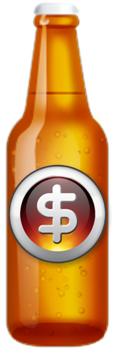By: Jeffrey Lapin
 A Canadian study of alcohol price, availability and death, found that when the minimum alcohol price was increased, alcohol-related deaths decreased fairly quickly. A 10% price increase was enough to significantly lower the death rate. This Study was recently published in the American Journal of Public Health, The Raising of Minimum Alcohol Prices in Saskatchewan, Canada: Impacts on Consumption and Implications for Public Health.
A Canadian study of alcohol price, availability and death, found that when the minimum alcohol price was increased, alcohol-related deaths decreased fairly quickly. A 10% price increase was enough to significantly lower the death rate. This Study was recently published in the American Journal of Public Health, The Raising of Minimum Alcohol Prices in Saskatchewan, Canada: Impacts on Consumption and Implications for Public Health.
THE STUDY
The Study was conducted by a number of Canadian researchers from Centre for Addictions Research of British Columbia, University of Victoria’s Department of Psychology, the Centre for Addiction and Mental Health (Toronto, Ontario), and Okanagan Research (Summerland, British Columbia). The lead researcher was Tim Stockwell.
The Study focused on British Columbia. It examined the price of alcohol, alcohol-related deaths and the availability of alcohol from 2002 and 2009.
STUDY FINDINGS
The Study’s most significant finding was that increased minimum alcohol prices were associated with immediate, substantial and significant reductions in wholly alcohol attributable deaths. More specifically, a 10% price increase was followed by a 32% drop in wholly alcohol attributable deaths. In addition, there were also a decrease in partially-related alcohol deaths two to three years after the price increases. Moreover, a 10% increase in the number of liquor stores was followed by a 2% rise in all alcohol related deaths. Other findings of the Study include:
- A 10% increase in minimum prices significantly reduced consumption of beer by 10.06%, spirits by 5.87%, wine by 4.58%, and all beverages combined by 8.43%;
- Consumption of coolers decreased significantly by 13.2%, cocktails by 21.3%, and liqueurs by 5.3%; and
- A 10% increase in minimum price was associated with a 22.0% decrease in consumption of higher strength beer (> 6.5% alcohol/volume) versus 8.17% for lower strength beers.
The Study offers this conclusion:
Minimum pricing is a promising strategy for reducing the public health burden associated with hazardous alcohol consumption. Pricing to reflect percentage alcohol content of drinks can shift consumption toward lower alcohol content beverage types.
About the Study, Mr. Stockwell stated, “This study adds to the scientific evidence that, despite popular opinion to the contrary, even the heaviest drinkers reduce their consumption when minimum alcohol prices increase.”
To read the entire Study: American Journal of Public Health: The Raising of Minimum Alcohol Prices in Saskatchewan, Canada: Impacts on Consumption and Implications for Public Health (Additional article information: Tim Stockwell, Jinhui Zhao, Norman Giesbrecht, Scott Macdonald, Gerald Thomas, and Ashley Wettlaufer. The Raising of Minimum Alcohol Prices in Saskatchewan, Canada: Impacts on Consumption and Implications for Public Health. American Journal of Public Health: December 2012, Vol. 102, No. 12, pp. e103-e110. doi: 10.2105/AJPH.2012.301094)
POSSIBLE IMPACT OF THE STUDY
British policy makers are planning on introducing a minimum alcohol price to decrease drinking. At least based on this author’s research, there is no legislation pending anywhere in the United States about minimum alcohol prices. The only current U.S. governmental influence on price is taxes and the issuance of liquor licenses. The Centers for Disease Control and Prevention website (Alcohol and Public Health- Fact Sheet) states:
There are approximately 80,000 deaths attributable to excessive alcohol use each year in the United States. This makes excessive alcohol use the 3rd leading lifestyle-related cause of death for the nation. Excessive alcohol use is responsible for 2.3 million years of potential life lost (YPLL) annually, or an average of about 30 years of potential life lost for each death. In 2006, there were more than 1.2 million emergency room visits and 2.7 million physician office visits due to excessive drinking. The economic costs of excessive alcohol consumption in 2006 were estimated at $223.5 billion.
Lawmakers here in the United States may want to consider minimum prices as a way to lower alcohol use and more importantly, alcohol-related deaths.
OTHER POSTS YOU MIGHT FIND INTERESTING
- Dramatic Increase in Fatal Vehicle Crashes Following Storm
- Going Beyond No Texting and Driving: Huron, South Dakota
- AMEX Changing the Rules: Arbitration Instead of Court
- The ABC’s Of Safe Winter Weather Driving
- FTC Pulls the Plug on Robocall “Rachel”
ABOUT LAPIN LAW OFFICES
Lapin Law Offices represents drivers, passengers and pedestrians and their families that are injured or killed in motor vehicle crashes caused by a drunk or intoxicated driver. You can learn more about us by calling us anytime (24/7) at 402-421-8033 (Lincoln), 888-525-8819 (Toll Free) or submitting your case online (Contact Us). We offer a free initial consultation and do not collect a fee unless we get money for you.

